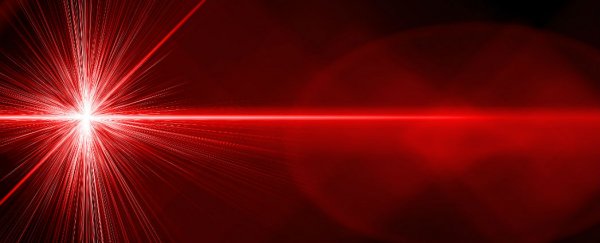Scientists in Japan have set the record for the most powerful laser ever fired, producing a 2 petawatt pulse - that's 2 quadrillion watts - using a device known as the Laser for Fast Ignition Experiment (LFEX). While they could only sustain it for a mere one-trillionth of a second, the team claims it had a concentrated energy equivalent of 1,000 times the world's electricity consumption.
Located at Osaka University, the LFEX laser projector is about 100 metres long, and combines four carefully positioned glass 'lamps' to amplify a laser beam over and over as it travels along the length of the device. This set-up allowed the team to produce an incredibly concentrated amount of power while consuming only a couple hundred joules of energy, which is about as much power your microwave uses in 2 seconds.
"With heated competition in the world to improve the performance of lasers, our goal now is to increase our output to 10 petawatts," one of the team Junji Kawanaka, an electrical engineer at Osaka University, said in a statement.
Is this awesome? Yep, but it's not going to be shooting down satellites or blowing up planets Death Star-style any time soon. While earlier this year Lockheed Martin was able to burn a hole through a car 1.6 km down the road using a mere 30-kilowatt laser, and German company MBDA Deutschland reportedly knocked drones out of the sky from 3 kilometres away using a 40-kilowatt laser, Japan's LFEX beam couldn't even come close to this.
"If one wanted to destroy a satellite, the Japanese LFEX laser would not be the answer, as it would not propagate far through the atmosphere - even if it could be pointed towards the satellite," Michael Donovan, the associate director of Texas Petawatt Laser program in the US, told Patrick Tucker at Defence One. "The higher you get, the thinner the atmosphere. So a laser launched in space could propagate, but a petawatt laser is too large to economically launch into space."
The Texas Petawatt Laser is the only comparable device in the world right now, able to produce a 1 petawatt laser pulse.
So why is it that a 30-kilowatt laser fired over more than a kilometre can do so much damage when a 2 petawatt blast can't even make it into space? "Turns out that petawatt lasers only work in a vacuum, because they ionise the air that they come in contact with," says Tucker. "That's the difference between a 'high-energy laser' of the military variety versus a 'peak power laser', like the one in Osaka."
Not that it hasn't got people comparing the LFEX laser to the Death Star super-weapon in the Star Wars universe. But let's be realistic here, we're gonna need a whole lot more power to blow up a planet the size of Alderaan. As Matt Springer explains at his blog, Built on Facts, if we're using Earth as an example, a laser powerful enough to blow it up would have have to produce around 2.2 x 1032 joules of energy.
"That's a preposterously huge amount of energy! It's a solid week of the Sun's entire power output," says Springer. "Dumping it in about a single second, as required to blow up Alderaan, is a very, very impressive feat. Doubly so when you take into account the fact that the binding energy is just enough to dissociate the planet into a diffuse cloud. If you want to actually blow the thing up into pieces flying out at many times escape velocity, you need much more energy."
When we compare 2.2 x 1032 joules of energy with the couple of hundred joules being produced by LFEX right now, I think it's safe to say the Death Star will be stuck in science fiction for a while yet.
